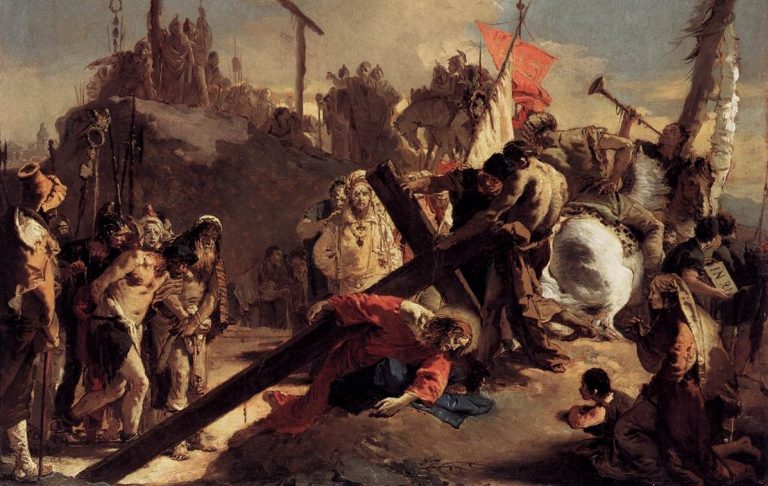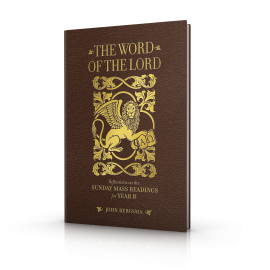By Sean Innerst
Sean Innerst, a convert to the Catholic faith from the Religious Society of Friends (Quakers), is a seminary professor and catechist. He is a contributor to the Catholic for a Reason series.

The feasts of Holy Week—Holy Thursday, Good Friday, Holy Saturday, and Easter—are fulfillments of the three spring Jewish feasts with which they originally coincided. We refer to the three great liturgies of Holy Week—the Mass of the Lord’s Supper on Holy Thursday evening, Good Friday services, and the Easter Vigil—as the Holy Triduum. In the year of Christ’s death, the Jewish Passover on 14 Nisan would have begun at sundown on Thursday, the same evening as the celebration of the Last Supper and been completed at sundown on Good Friday, the day of His death.
What we call Holy Saturday, the day that Christ lay in the tomb, a day without its own liturgy, coincides with the first day of the feast of Unleavened Bread on 15 Nisan, which is closely associated with Passover. Leaven, a sign of sin, is cleansed from all Jewish homes on the eve of Passover. And the following seven days of Unleavened Bread, called in Deuteronomy 16:3 “the bread of affliction,” are observed, beginning the day after Passover, as a memorial of the flight from Egypt and as a reminder to each Jew “of what the Lord did for me when I came out of Egypt” (Ex 13:8).
The feast of First Fruits, which coincided that year with the day of Christ’s Resurrection and commemorated the first sheaf of the barley harvest, began after sundown of 15 Nisan (according to Jewish reckoning the beginning of 16 Nisan). This feast, involving a ceremonial cutting and offering of the first fruit of this harvest, asks God’s blessing in anticipation of the full harvest in the spring at the Feast of Weeks or Pentecost.
To sum up, Jesus died on the afternoon of Passover, a day on which a lamb was slain and eaten to commemorate the sparing of the firstborn of Israel during the tenth plague in Egypt. Just as the blood of the lamb was placed on the doorposts of the households of Israel to ensure their salvation as the angel of death struck the firstborn of Egypt, so now in Christ, the blood of the slain Lamb of God saves us from the death of sin. On the day we call Holy Saturday, while the Jews celebrated the rejection of sin on the feast of Unleavened Bread, the body of Jesus, who had offered Himself to His apostles as the bread of life at the Last Supper and had definitively defeated sin by His death on the Cross, lay in the tomb. On Easter Sunday morning, Jesus revealed Himself as what Saint Paul would later call “the first fruits of those who have fallen asleep” (1 Cor 15:20). And this He did on the very day that the Jews called First Fruits! So, Jesus instituted the Eucharist and died on Passover, lay buried during the feast of Unleavened Bread, and rose on First Fruits.
As we know from the account in Acts 2, on the first Christian Pentecost—the day during which the Jews were celebrating the harvest and the giving of the Law on Mount Sinai fifty days after the Exodus— the promise of the first fruits, seen in Christ’s Resurrection, finds its fulfillment in the sending of the Holy Spirit and a harvest of three thousand souls from every nation of the Jewish diaspora. It is worth noting that, at the giving of the Law at Mount Sinai, three thousand died as a consequence of their failure of faith and the subsequent idolatrous worship of the golden calf (Ex 32:28), whereas on this fulfillment of the Jewish Pentecost, three thousand die to sin in the waters of Baptism and come to new life in the Risen Christ (Acts 2:38–42).
You Might Also Like
The Catholic Lectionary guides us through the liturgical year, presenting Old and New Testament readings that together reveal God’s unfolding plan for our salvation. In The Word of the Lord: Reflections on the Sunday Mass Readings for Year B, biblical scholar Dr. John Bergsma provides commentary on each Sunday’s unique presentation of readings.
